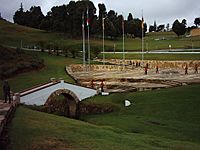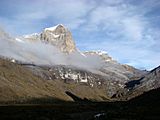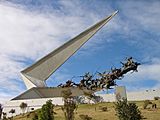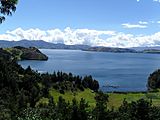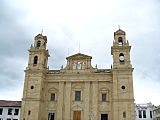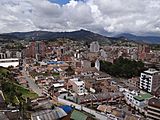Boyacá facts for kids
Quick facts for kids
Boyaca Department
Departamento de Boyacá
|
|||
|---|---|---|---|
|
Department of Colombia
|
|||
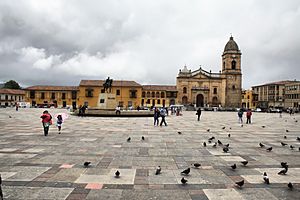
Simón Bolívar square, Tunja
|
|||
|
|||
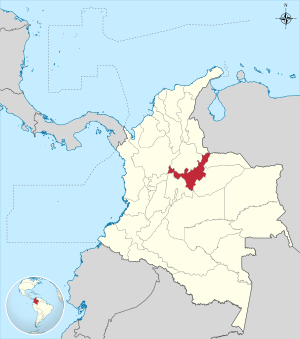
Location of Boyacá, in red, in Colombia
|
|||
| Country | |||
| Capital | Tunja | ||
| Municipalities | 123 | ||
| Area | |||
| • Total | 23,189 km2 (8,953 sq mi) | ||
| Population
(2005)
|
|||
| • Total | 1,255,311 | ||
| • Density | 54.1339/km2 (140.2062/sq mi) | ||
| Demonym(s) | Boyacense | ||
| Time zone | UTC-5 (UTC) | ||
| Postal code |
15
|
||
| ISO 3166 code | CO-BOY | ||
| Website | Gobernación de Boyacá | ||
Boyacá is one of the 32 departments of Colombia. It is in the central northeastern part of the country, almost entirely within the mountains of the Eastern Cordillera to the border with Venezuela, although the western end of the department extends to the Magdalena River. Its capital is Tunja.
Boyacá is known as "The Land of Freedom" because in this region there were several battles that resulted in the independence of Colombia from Spain.
Contents
History
The territory of present-day Boyacá was inhabited, during the Pre-Columbian time, by Muisca indigenous peoples. They lived mainly by agriculture and mining gold and emeralds.
The first European to discover the area was the Spaniard Gonzalo Jiménez de Quesada. In 1539, Gonzalo Suárez Rendón, a Spanish colonist, founded the city of Tunja and other places. Tunja became one of the main political and economic centers for the Spanish during the "Viceroyalty of New Granada".
During the 19th century Boyaca was battleground of several important battles during the war of Independence; two of the most important were the "Battle of the Pantano de Vargas" (Vargas Swamp Battle) on 25 July 1819, and the "Battle of Boyacá" on 7 August 1819.
Geography
The Boyacá department is in the Andean region over the mountains of the Eastern Cordillera (the eastern section of the Andes in Colombia). It borders 8 departments: Santander and Norte de Santander to the north, Arauca and Casanare to the east, Cundinamarca and Meta to the south, and Caldas and Antioquia to the west. It also borders with Venezuela.
 |
Santander | Santander | Norte de Santander, Venezuela, Arauca |  |
| Antioquia | Casanare | |||
| Cundinamarca, Caldas | Cundinamarca, Meta | Casanare |
Boyacá has an area of 23,189 km2 (8,953 sq mi), most of it on a plateau. Its highest point is Ritacuba Blanco (6°29′40″N 72°17′47″W / 6.49444°N 72.29639°W) in the Eastern Cordillera; it is 5,410 m (17,749 ft) high.
Many rivers start in this area; the most important are the Chicamocha and Arauca rivers, tributaries to other important rivers such as the Magdalena and Meta rivers.
Boyacá also has numerous lakes; the largest, and the largest in Colombia, is the Lake Tota with an area of 55 km2 (21 sq mi).
Climate
The area around Tunja, at an altitude of about 2,828 m (9,278 ft), is characterized by climates with few extremes of temperature and ample precipitation in all months. The Köppen climate classification type for the climate at Tunja is a "Marine West Coast Climate" and of the subtype "Cfb".
The average amount of precipitation for the year in Tunja is 645.2 mm (25.4 in). The month with the most precipitation on average is October with 86.4 mm (3.4 in) of precipitation. The month with the least precipitation on average is January with an average of 15.2 mm (0.6 in). There is an average of 179.0 days of precipitation, with the most precipitation occurring in May with 19.0 days and the least precipitation occurring in January with 6.0 days.
The average temperature for the year in Tunja is 13.2 °C (55.8 °F). The warmest month, on average, is March with an average temperature of 14.1 °C (57.4 °F). The coolest month on average is July, with an average temperature of 12.2 °C (54.0 °F).
| Climate data for Tunja, Colombia | |||||||||||||
|---|---|---|---|---|---|---|---|---|---|---|---|---|---|
| Month | Jan | Feb | Mar | Apr | May | Jun | Jul | Aug | Sep | Oct | Nov | Dec | Year |
| Mean daily maximum °C (°F) | 19.1 (66.4) |
19.3 (66.7) |
19.2 (66.6) |
18.4 (65.1) |
17.3 (63.1) |
16.4 (61.5) |
16.0 (60.8) |
16.5 (61.7) |
17.3 (63.1) |
17.9 (64.2) |
18.2 (64.8) |
18.4 (65.1) |
17.8 (64.1) |
| Daily mean °C (°F) | 13.2 (55.8) |
13.7 (56.7) |
14.1 (57.4) |
14.1 (57.4) |
13.5 (56.3) |
12.8 (55.0) |
12.2 (54.0) |
12.3 (54.1) |
12.8 (55.0) |
13.3 (55.9) |
13.6 (56.5) |
13.1 (55.6) |
13.2 (55.8) |
| Mean daily minimum °C (°F) | 7.2 (45.0) |
8.1 (46.6) |
9.0 (48.2) |
9.7 (49.5) |
9.7 (49.5) |
9.1 (48.4) |
8.4 (47.1) |
8.2 (46.8) |
8.2 (46.8) |
8.7 (47.7) |
9.0 (48.2) |
7.8 (46.0) |
8.6 (47.5) |
| Average rainfall mm (inches) | 16 (0.6) |
29 (1.1) |
55 (2.2) |
77 (3.0) |
84 (3.3) |
58 (2.3) |
46 (1.8) |
42 (1.7) |
54 (2.1) |
85 (3.3) |
69 (2.7) |
31 (1.2) |
646 (25.3) |
| Source: Weatherbase.com [1] | |||||||||||||
Provinces and Municipalities
There are 13 provinces and two special districts in the Boyacá Department, listed below with their 123 municipalities. The provincial capitals are in bold.
|
Centro
Gutiérrez
La Libertad
Lengupá
|
Occidente
Márquez
Neira
|
Norte
Oriente
Ricaurte
|
Sugamuxi
Tundama
Valderrama
Distrito Fronterizo
Special Handling Zone
|
Demographics
The inhabitants of the Boyacá department are known, in Spanish, as Boyacense.
Boyacá had a population, in 2005, of 1,255,311, for a population density of 54.1 inhabitants/km2.
Population history in Boyacá
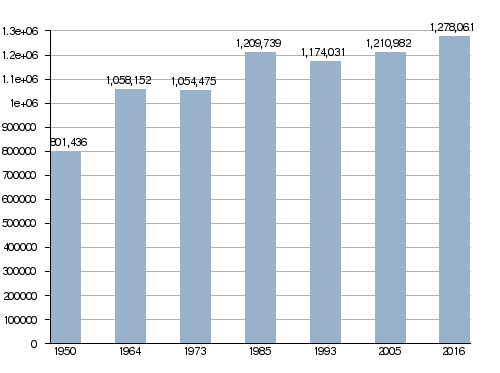
The 10 municipalities with more inhabitants in the Boyacá department are:
| City | Population (2005) |
Province |
|---|---|---|
| Tunja | 154,096 | Centro |
| Sogamoso | 117,094 | Sugamuxi |
| Duitama | 107,406 | Tundama |
| Chiquinquirá | 55,786 | Occidente |
| Puerto Boyacá | 50,301 | Special Handling Zone |
| Paipa | 27,766 | Tundama |
| Moniquirá | 21,852 | Ricaurte |
| Samacá | 17,614 | Centro |
| Garagoa | 16,520 | Neira |
| Villa de Leyva | 12,032 | Ricaurte |
Economy
Farming is an important activity; some crops grown here are sugarcane, coffee and cacao. Cattle raising is also important.
Mining is also an important activity, mainly of emerald and coal.
Places of interest
Some places of interest in the department are:
- Monument to the Lancers (Spanish: Monumento a los Lanceros) a memorial for Vargas Swamp Battle. It is the largest monument in Colombia.
- Villa de Leyva is a touristic colonial town and municipality. The town is at 37 kilometres (23 mi) west of the departmental capital Tunja.
- Battleground of the Battle of Boyacá, to the south of Tunja.
- Puente de Boyacá (in English: The Bridge of Boyacá) is a small bridge at 14 km (8.7 mi) to the west of Tunja. It commemorates the historic battle of 7 August 1819 known as the Battle of Boyacá.
- Lake Tota, the largest lake of fresh water of the country.
- Basílica of Our Lady of the Rosary in Chiquinquirá. Our Lady of the Rosary is the patron saint of Colombia.
Gallery
-
Duitama downtown
See also
 In Spanish: Boyacá (desambiguación) para niños
In Spanish: Boyacá (desambiguación) para niños




